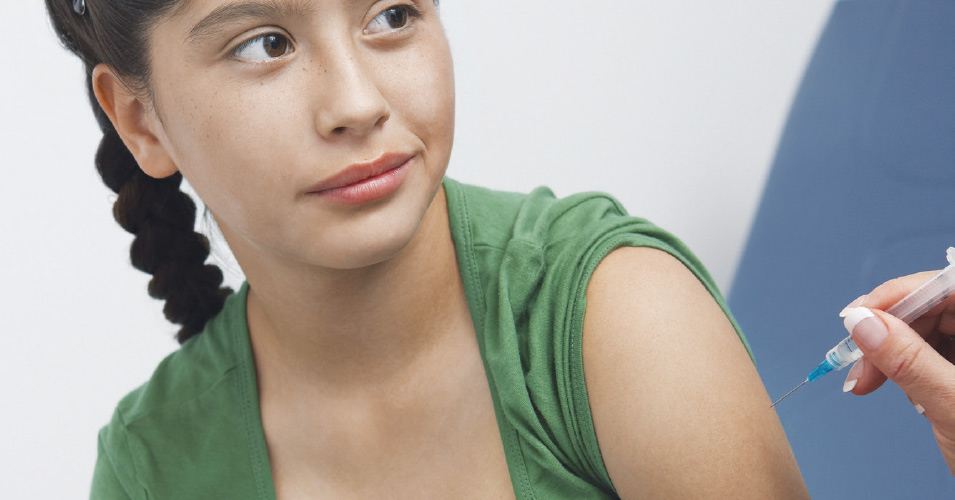If there were a vaccine for breast cancer, she wouldn’t be able to close the office doors ever, says Dr. Linda Imboden of Brighton Hill Pediatrics in Syracuse. Yet nearly half the teenagers in the United States remain without the vaccine known to prevent most cervical and throat cancers.
Human papillomavirus, or HPV, has been found to cause most cervical and vaginal cancers as well as throat cancer and genital warts in men and women. This is tough stuff to talk about with adolescents and even parents. The virus is considered a sexually transmitted disease. But doctors recommend the three-shot series that makes up the vaccine be given at some time from ages 11 to 13. The shot is approved now from ages 9 to 26, but it is most effective when given earlier or before teens become sexually active, according to two Syracuse pediatricians.
“I can’t even understand people not wanting it,” Imboden says. Medical insurance these days covers the cost of the three-shot vaccination, according to two medical offices.
When told what the vaccine is for, one 12-year-old girl said to her mother, “But I’m not going to have sex now, Mom.” That’s the point, doctors say: Vaccinate before children become teens and young adults become sexually active.
One mother of two girls, Denise DiRienzo of Pompey, says she was initially hesitant about the vaccine due to early advertising. But she’s talked to several physicians about it and done some more research, enough to quiet the debate in her home. “We should take every step as a parent to keep them from contracting a devastating illness,” DiRienzo says. “It seems it’s just preventive care.”
“The side effects seem minimal,” she notes, which the pediatricians confirmed. The side effects are the same ones that can follow other vaccinations, such as pain at the location of the shot, nausea or slight fever. “It’s really safe,” Imboden says. “Well over 40 million doses have been given.”
In June The New York Times editorialized in favor of parents getting their daughters vaccinated. The paper’s editorial board noted that the percent of girls infected with high-risk strains of the HPV virus declined by half in recent years, an improvement attributed to the vaccine.
But only 40 percent of teenage girls are getting vaccinated, according to the U.S. Centers for Disease Control and Prevention. That amount should have increased in recent years due to the success noted in the aforementioned studies. In comparison, the vaccination rate is way over 75 percent in Australia and even Rwanda, the CDC notes.
“Unfortunately (these days) everyone is very skeptical about vaccines, which is really kind of sad because they have prevented so many deaths and illnesses,” says Dr. Kathleen Shefner, a Syracuse pediatrician whose children in the appropriate age range received the vaccine. Also, because this vaccine is aimed at a sexually transmitted disease, some parents initially felt uncomfortable, as if by allowing the vaccinations they were encouraging their children to become sexually active.
“I would suggest that—because this is a vaccine for sexually transmitted diseases—parents look at communicating as openly as possible when they feel that (their children) are ready to deal with these types of issues,” Shefner says. Open communication is “actually the best protection we can give them—so that they understand what the consequences of actions can be and feel that there’s somebody at home that they can talk to.”
HPV is responsible for about 19,000 cancers diagnosed in women each year, of which cervical cancer is the most common, according to the CDC. About 8,000 cancers in men are caused by HPV each year, the most common of which is throat cancer.
Two types of the vaccine are available. Cervarix, which is just for females, prevents two strains of HPV, and Gardasil, which is for females and males, prevents those two strains plus two more. Each vaccine is given in three doses. After the first shot, the patient should return two months later for the second and then four months after that for the third shot. The effectiveness is better if a person receives all three shots and gets them in the correct time period, Shefner says.
Adolescents get vaccinated for meningitis at age 11 and whooping cough at 12, Imboden notes—not to mention the flu vaccine possibly every fall. “They could have one crummy day with a lot of shots or you could wait until 12 years old,” she says. “You have to discuss it with your doctor.”
“Our job as pediatricians is really trying to protect our children,” Shefner says. The vaccine is “a really valuable tool and it’s going to prevent a lot of illness down the road.”



